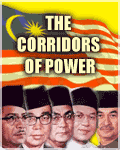
Out of the 89 parliamentary seats that Pakatan Rakyat won, 53 are non-Malay/Muslim seats while only 36 can be said to be Malay/Muslim-majority seats. Umno, however, won 88 seats just by itself (almost the same as for DAP, PKR and PAS combined). Then there were another 12 non-Malay/Muslim seats with 33 from the native areas in East Malaysia.
THE CORRIDORS OF POWER
Raja Petra Kamarudin
Okay, let’s say Pakatan Rakyat won or wins the general election. Then let’s say Pakatan Rakyat does what it promises to do: it cancels the citizenship of 1.5 million ‘illegal’ citizens, mostly from East Malaysia, and kicks these people out of the country. Then Pakatan Rakyat ends the gerrymandering and, like some countries, passes a law so that the variance between seats is, say, within plus-minus 20%.
Can this be done?
Unfortunately it can’t. Currently, Sabah and Sarawak control 25% of the seats in Parliament even though it has about 19-20% of the population of Malaysia. And if you cancel the citizenship of one million or 1.5 million citizens, it would be even less than 20%, maybe just 15-16%. However, they will still control 25% of the seats in Parliament.
Hence, due to the agreement, it would be impossible to implement the plus-minus 20% variance between seats since, if you do this, you will then create more seats in West Malaysia and thus you will have to correspondingly increase the number of seats in East Malaysia to ensure that you maintain their 25% share of the seats.
And this would make it worse. The variance, because of East Malaysia, would get wider and you actually increase more seats in Barisan Nasional’s ‘fixed deposit’ region. For every three seats you increase in West Malaysia, you need to increase one more seat in East Malaysia.
What will happen in the end is: the seats will be divided into three categories. For the urban areas the seats may be, say, 80,000-120,000 voters (roughly 20% or so variance calculated on 100,000 voters per seat). For the semi-urban areas they may be 50,000-79,000 voters (roughly 20% or so variance calculated on 65,000 voters per seat). And for the rural areas they may be 30,000-49,000 voters (roughly 20% or so variance calculated on 40,000 voters per seat).
And after you redraw the election boundaries and increase the number of seats, you will end up creating more seats in the rural areas and East Malaysia, which can only work to Barisan Nasional’s favour. Furthermore, you need a two-thirds majority in Parliament to do this and you are never going to see a two-thirds majority for either Barisan Nasional or Pakatan Rakayat for a long time to come. The days of two-thirds majorities are gone.
But will Pakatan Rakyat support whatever proposal is tabled by Barisan Nasional? Certainly not, because whatever proposal Barisan Nasional tables will certainly be in its favour. And vice versa for Pakatan Rakyat if it happens to be in power: because whatever proposal Pakatan Rakyat tables will also be in its favour.
And that would mean Pakatan Rakyat’s supporters would all be lumped in the urban and semi-urban areas while Barisan Nasional’s supporters would be spread out in the rural areas and in East Malaysia. And this would also mean that Barisan Nasional could still stay in power with less than 50% of the popular votes while Pakatan Rakyat cannot get into power even with 55% of the popular votes.
Now, what was the strategy for both Barisan Nasional and Pakatan Rakyat in the recent general election on Sunday, 5th May 2013? I am not sure what Pakatan Rakyat’s strategy was but I think it was mainly to get the crowd.
And this they did.
Barisan Nasional, however, had a more devious strategy (devious only if you look at it through the eyes of an opposition supporter but clever if through the eyes of Machiavelli). Barisan Nasional’s strategy was to turn Pakatan Rakyat into a Chinese-dominated coalition and Barisan Nasional into a Malay-dominated opposition.
And this they did.
Out of the 89 parliamentary seats that Pakatan Rakyat won, 53 are non-Malay/Muslim seats while only 36 can be said to be Malay/Muslim-majority seats. Umno, however, won 88 seats just by itself (almost the same as for DAP, PKR and PAS combined). Then there were another 12 non-Malay/Muslim seats with 33 from the native areas in East Malaysia.
Without the MCA/MIC/Gerakan seats included, Umno and the ‘natives’ won 121 seats in Parliament -- enough to form the government even without the help of MCA, MIC and Gerakan.
Umno intentionally wanted Pakatan Rakyat to appear Chinese and less multi-racial. They also wanted the Malays in Pakatan Rakyat to appear like ‘tools’ of the Chinese. And to do this they need to play the race card -- which they are currently doing.
Can you now understand the reason for this sudden surge in Chinese-bashing? It is all part of the plan to make Pakatan Rakyat appear Chinese. And the Chinese supporters of Pakatan Rakyat are not helping much either. The more Malay-bashing you indulge in, the more you strengthen Umno’s strategy.



TO BE CONTINUED



No comments:
Post a Comment
Note: Only a member of this blog may post a comment.